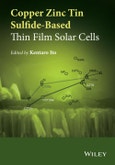The semiconducting compound (CZTS) is made up earth-abundant, low-cost and non-toxic elements, which make it an ideal candidate to replace Cu(In,Ga)Se2 (CIGS) and CdTe solar cells which face material scarcity and toxicity issues. The device performance of CZTS-based thin film solar cells has been steadily improving over the past 20 years, and they have now reached near commercial efficiency levels (10%). These achievements prove that CZTS-based solar cells have the potential to be used for large-scale deployment of photovoltaics.
With contributions from leading researchers from academia and industry, many of these authors have contributed to the improvement of its efficiency, and have rich experience in preparing a variety of semiconducting thin films for solar cells.
Table of Contents
Preface ix
List of Contributors xi
Part I Introduction 1
1 An Overview of CZTS-Based Thin-Film Solar Cells 3
Kentaro Ito
1.1 Introduction 3
1.2 The Photovoltaic Effect 4
1.3 In Pursuit of an Optimal Semiconductor for Photovoltaics 22
1.4 Conclusions 36
Acknowledgements 37
References 37
2 Market Challenges for CZTS-Based Thin-Film Solar Cells 43
Arnulf Jäger-Waldau
2.1 Introduction 43
2.2 Compound Thin-Film Technologies and Manufacturing 45
2.3 Challenges for CZTS Solar Cells in the Market 49
2.4 Conclusion 51
References 51
Part II The Physics and Chemistry of Quaternary Chalcogenide Semiconductors 53
3 Crystallographic Aspects of Cu2ZnSnS4 (CZTS) 55
Susan Schorr
3.1 Introduction: What Defines a Crystal Structure? 55
3.2 The Crystal Structure of CZTS 57
3.3 Point Defects in CZTS and the Role of Stoichiometry 68
3.4 Differentiation between Intergrown Kesterite- and Stannite-Type Phases: A Simulational Approach 71
3.5 Summary 72
References 73
4 Electronic Structure and Optical Properties from First-Principles Modeling 75
Clas Persson, Rongzhen Chen, Hanyue Zhao, Mukesh Kumar and Dan Huang
4.1 Introduction 75
4.2 Computational Background 77
4.3 Crystal Structure 80
4.4 Electronic Structure 82
4.5 Optical Properties 97
4.6 Summary 101
Acknowledgements 102
References 102
5 Kesterites: Equilibria and Secondary Phase Identification 107
Dominik M. Berg and Phillip J. Dale
5.1 Introduction 107
5.2 Chemistry of the Kesterite Reaction 108
5.3 Phase Identification 116
Acknowledgements 128
References 128
6 Growth of CZTS Single Crystals 133
Akira Nagaoka and Kenji Yoshino
6.1 Introduction 133
6.2 Growth Process 134
6.3 Properties of CZTS Single Crystals 141
6.4 Conclusion 145
Acknowledgements 146
References 146
7 Physical Properties: Compiled Experimental Data 149
Sadao Adachi
7.1 Introduction 149
7.2 Structural Properties 150
7.3 Thermal Properties 152
7.4 Mechanical and Lattice Dynamic Properties 157
7.5 Electronic Energy-Band Structure 162
7.6 Optical Properties 169
7.7 Carrier Transport Properties 170
References 176
Part III Synthesis of Thin Films and Their Application to Solar Cells 181
8 Sulfurization of Physical Vapor-Deposited Precursor Layers 183
Hironori Katagiri
8.1 Introduction 183
8.2 First CZTS Thin-Film Solar Cells 184
8.3 ZnS as Zn-Source in Precursor 184
8.4 Influence of Absorber Thickness 187
8.5 New Sulfurization System 188
8.6 Influence of Morphology 189
8.7 Co-Sputtering System with Annealing Chamber 190
8.8 Active Composition 191
8.9 CZTS Compound Target 192
8.10 Conclusions 201
References 201
9 Reactive Sputtering of CZTS 203
Charlotte Platzer-Björkman, Tove Ericson, Jonathan Scragg and Tomas Kubart
9.1 Introduction 203
9.2 The Reactive Sputtering Process 205
9.3 Properties of Sputtered Precursors 206
9.4 Annealing of Sputtered Precursors 214
9.5 Device Performance 215
9.6 Summary 217
References 217
10 Coevaporation of CZTS Films and Solar Cells 221
Thomas Unold, Justus Just and Hans-Werner Schock
10.1 Introduction 221
10.2 Basic Principles 221
10.3 Process Variations 227
Acknowledgements 236
References 236
11 Synthesis of CZTSSe Thin Films from Nanocrystal Inks 239
Charles J. Hages and Rakesh Agrawal
11.1 Introduction 239
11.2 Nanocrystal Synthesis 241
11.3 Nanocrystal Characterization 249
11.4 Sintering 251
11.5 Conclusion 264
References 264
12 CZTS Thin Films Prepared by a Non-Vacuum Process 271
Kunihiko Tanaka
12.1 Introduction 271
12.2 Sol-Gel Sulfurization Method 272
12.3 Preparation of CZTS Thin Films by Sol-Gel Sulfurization Method 274
12.4 Chemical Composition Dependence 279
12.5 H2S Concentration Dependence 282
12.6 CZTS Solar Cell Prepared by Non-vacuum Processes 284
References 285
13 Growth of CZTS-Based Monograins and Their Application to Membrane Solar Cells 289
Enn Mellikov, Mare Altosaar, Marit Kauk-Kuusik, Kristi Timmo, Dieter Meissner, Maarja Grossberg, Jüri Krustok and Olga Volobujeva
13.1 Introduction 289
13.2 Monograin Powder Growths, Basics of the Process 291
13.3 Influence of Chemical Etching on the Surface Composition of Monograins 295
13.4 Thermal Treatment of CZTS-Based Monograins 298
13.5 Optoelectronic Properties of CZTS-Based Monograins and Polycrystals 300
13.6 Conclusion 306
References 306
Part IV Device Physics of Thin-Film Solar Cells 311
14 The Role of Grain Boundaries in CZTS-Based Thin-Film Solar Cells 313
Joel B. Li and Bruce M. Clemens
14.1 Introduction 313
14.2 CIGSe and CdTe Solar Cells 314
14.3 CZTS-Based Thin-Film Solar Cells 318
14.4 Conclusion 327
References 328
15 CZTS-Based Thin-Film Solar Cells Prepared via Coevaporation 335
Byungha Shin, Talia Gershon and Supratik Guha
15.1 Introduction 335
15.2 Preparation of CZTS and CZTSe Absorbers 337
15.3 Fundamental Properties of Coevaporated CZTS and CZTSe Absorbers 338
15.4 Device Characteristics of Full-Sulfide CZTS Thin-Film Solar Cells 348
15.5 Device Characteristics of Full-Selenide CZTSe Thin-Film Solar Cells 354
15.6 Summary 358
References 358
16 Loss Mechanisms in Kesterite Solar Cells 363
Alex Redinger and Susanne Siebentritt
16.1 Introduction 363
16.2 Current State-of-the-Art CZTS-Based Thin-Film Solar Cells 364
16.3 Dominant Recombination Path 366
16.4 Band-Gap Variations 372
16.5 Series Resistance and its Relation to Voc Losses 376
16.6 Conclusion 381
Acknowledgements 382
References 382
17 Device Characteristics of Hydrazine-Processed CZTSSe 387
Oki Gunawan, Tayfun Gokmen and David B. Mitzi
17.1 Introduction 387
17.2 Device Characteristics 389
17.3 Summary 406
Acknowledgements 407
References 408
Subject Index 413








